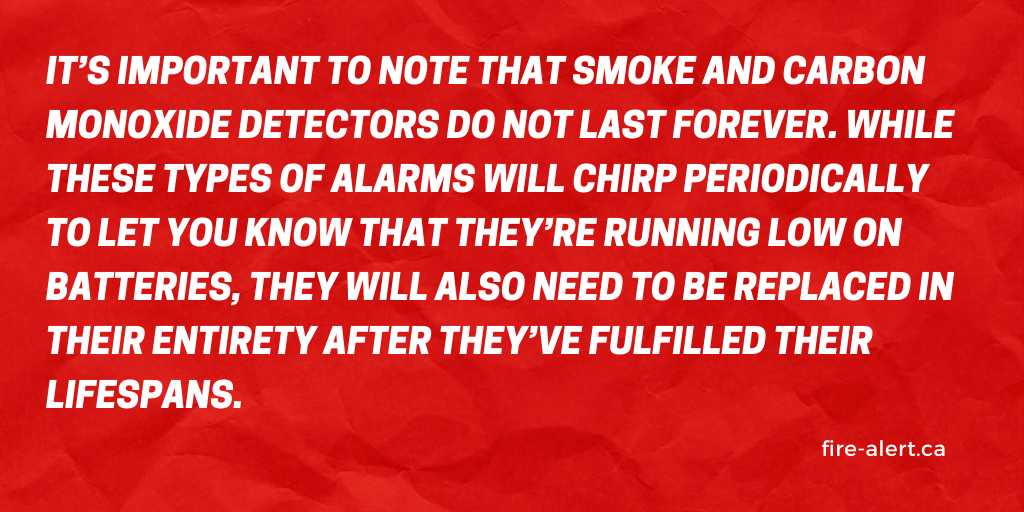How to Get the Most Out of Your Current Smoke Detectors
Did you know that almost three of every five home fire deaths resulted from fires in homes with no smoke alarms or no working smoke alarms? This statistic among many others prove how important it is to have working smoke detectors in your home, and to ensure that you’re getting the most out of their placement. In this article, we take a look at how to know when it’s time to replace your current smoke alarms, as well as how to make sure your working smoke alarms are positioned effectively.
The Lifespan of Smoke and Carbon Monoxide Detectors

It’s important to note that smoke and carbon monoxide detectors do not last forever. While these types of alarms will chirp periodically to let you know that they’re running low on batteries, they will also need to be replaced in their entirety after they’ve fulfilled their lifespans.
ProTech Security tells us more on the lifespan of smoke and carbon monoxide detectors and how often they should be replaced:
“Most smoke alarms have a lifespan of eight to 10 years, and again, replace the batteries every year. A smoke detector with a lithium battery or a hard-wired smoke detector can last 10 years, at which time you would just replace the whole unit. Carbon monoxide detectors last between five and seven years. The recommendation is to replace them every five years because their ability to detect carbon monoxide is questionable after that point.”
How Can You Tell if Your Smoke Alarm is Broken or Expired?
Unfortunately, it may not be obvious to you that your smoke alarm is broken or expired. Statistics show that in fires in which the smoke alarms were present but did not operate, two of every five (41%) of the smoke alarms had missing or disconnected batteries. While age is one indicator that your smoke alarm may no longer be working, there are other factors that may also give this away.
Koorsen Fire & Security gives us three ways to tell if your smoke alarm is broken or expired:
“The device is already ten years old or more. The date of manufacture is usually written on the device and, in some cases, the expiration date as well. If all you have is the manufacture date, simply calculate ten years from the time and see if the device is not too old to be in use.
Your smoke alarm suddenly trips off for no reason. That might be because dirt, smoke, humidity, steam, insects, or other contaminants have ruined the device’s sensors.
The expiration and manufacture date no longer appear on the device. That is probably because the device has passed its expiration period. When you notice any of these issues, it is time to change the smoke alarm.”
How to Get the Most Out of Your Current Smoke Detectors
Now that you’re sure that your smoke detector is working and doesn’t need replacement, how can you make sure that you’re getting the most out of your current smoke detectors? While many homeowners are under the impression that one on each floor should suffice (with one being directly beside a hot stove), these types of placements will not allow you to get the most out of your current smoke detectors.
Cove Smart explains the optimal placement for smoke detectors in residential homes:
“Make sure you have installed smoke detectors in every bedroom as well as outside of every bedroom. They should also be on every level of your home. Do not install smoke detectors near windows, ducts, bathrooms or stoves, as the drafts/steam/cooking smoke could set off a false alarm. Test your smoke detectors once a month by pushing the test alarm button. Change your smoke detector batteries at least once a year. If your smoke detector gives off a low battery signal (chirping sounds), replace batteries as soon as possible. Clean your smoke detectors and its surrounding areas – use a duster or vacuum extension to suck up excess dust and cobwebs. Take note of the expiration date and replace it when the time comes. You can even set a calendar reminder to help keep the date top of mind.”
Fire-Alert takes pride in equipping homeowners, commercial businesses, and government buildings with all necessary fire safety devices to ensure the well-being of families and employees across the nation. Reach out to us using our contact form to find out more.